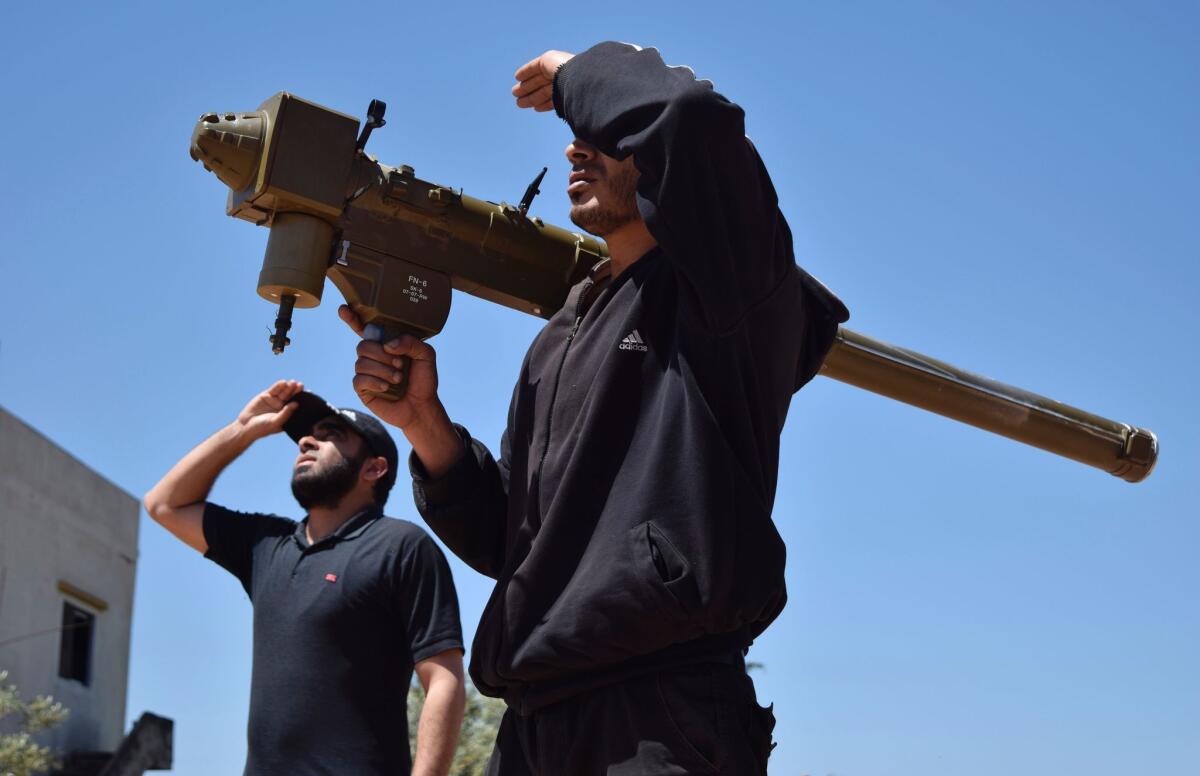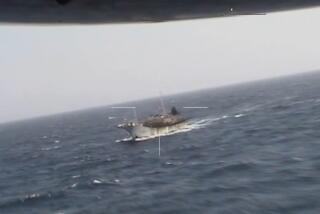As Russian planes bombard Syrian rebels, debate over anti-aircraft missiles returns

Rebel fighters monitor the sky holding an FN-6 man-portable air-defense system, or MANPAD, in the Syrian village of Teir Maalah, on the northern outskirts of Homs, on April 20, 2016.
Reporting from Amman, Jordan — It has been a difficult month for the Syrian air force and its Russian allies. In April alone, rebel forces claimed to bring down three aircraft: two Syrian jets and one Russian helicopter. Each incident sparked a frenzy of speculation about whether the opposition had obtained anti-aircraft missiles that could bring down planes, known as Man-Portable Air Defense Systems, or MANPADS.
The rebels had obtained a limited supply of the missiles from Syrian army depots and from the government of Qatar earlier in the war. They have long been asking the West to supply them with more.
As President Bashar Assad’s government and the Russians step up their airstrikes on rebel-held areas -- and civilian casualties mount – those calls have gained renewed urgency. But new technology might make MANPADS ineffective against Russian planes, while the risk that the weapons could ultimately be turned against the West remains.
See the most-read stories this hour >>
The U.S. has been reluctant to give MANPADS to the rebels, for fear the weapons could fall into the hands of extremist groups and be used against civilian airliners or Western military aircraft in other conflict zones. Critics have pointed to the caches of antitank missiles that made their way to hard-line and Islamist factions in Syria after the CIA gave them to select rebel factions. “It only takes one stray MANPAD to sneak into Turkey and that would be a very bad thing,” a U.S. official said, speaking on the condition of anonymity to discuss internal concerns about supplying the weapons.
Russia has been conducting more frequent airstrikes in northern Syria in recent days, particularly around the country’s largest city, Aleppo. The country has said it is targeting positions held by the Al Qaeda affiliate in Syria, Nusra Front, but U.S. intelligence officials believe Russia is targeting forces opposed to the Syrian government.
The pressure on the U.S. and its allies in the region to provide heavier weapons to opposition militias will increase if Russian-backed Syrian forces fully break the ceasefire, which has held in most of Syria for six weeks, the official said. Last month, the Wall Street Journal reported that the CIA is preparing a “Plan B” in case the ceasefire completely crumbles that involves supplying vetted moderate rebel fighters with MANPADS.
NEWSLETTER: Get the day’s top headlines from Times Editor Davan Maharaj >>
Gulf countries that have supplied the rebels with missiles, such as Saudi Arabia and Qatar, say that with Russia’s entry into the war on the side of Assad’s forces in September, the introduction of the weapons would swing the tide of the war in the rebels’ favor. “We believe that introducing surface-to-air missiles in Syria is going to change the balance of power on the ground,” said Saudi Foreign Minister Adel Jubair in an interview with Der Spiegel. “It will allow the moderate opposition to be able to neutralize the helicopters and aircraft that are dropping chemicals and have been carpet-bombing them, just like surface-to-air missiles in Afghanistan were able to change the balance of power there.”
“That place is awash in MANPADS,” Director of National Intelligence James R. Clapper told reporters in Washington on April 25. “The regime had them, there are active procurement networks, black markets, whatever,” he said.
Rebels have been unable to make more use of the missiles because of a lack of functioning batteries to power them. Once turned on, a MANPAD battery lasts only 30 to 90 seconds, and is extremely difficult to recharge without proper equipment, according to a report by the Small Arms Survey, a weapons monitor based in Geneva.
The rebels have largely countered airstrikes with “flak traps,” a World-War II-era tactic utilizing multiple machine-gun platforms placed along the path of jets or helicopters on bombing runs. In March, rebels affiliated with the Western-backed Jaish al-Nasr faction [Army of Victory] shot down a Syrian MIG-21 near the village of Kafr Nabudah, 25 miles northwest of the city of Hama, with the combined firepower of 10 machine guns, according to Mohammad Rashid, the spokesman of the group.
The opposition is not expecting that the West will change its mind about supplying them with weapons to fend off the mounting airstrikes. “We do not expect any of the rumors [of being armed by the West] to come true,” Major Bilal Al-Harba, a spokesman for the opposition’s Homs Liberation faction, said in an interview on social media. “If we get anything it will be from the regime, whether through fighting or by getting it from soldiers we bribe and who cooperate with us.”
They are nonetheless increasingly providing their fighters with training in the use of MANPADS. Al-Harba is part of a faction that has been giving Free Syrian Army troops basic courses they would need to operate any missile they encounter.
It is not clear if these weapons would be effective against the Russian air force. The Russian planes are equipped with more sophisticated weaponry and avionics, and can strike their targets from a higher altitude than their Syrian counterparts and stay beyond the reach of the operational ceiling of MANPADS found in Syria. Most of the downed planes have been the low-flying jets and helicopters of the government, with older, overworked airframes from the ‘50s and ‘60s that have been mothballed by the world’s armed forces elsewhere.
New Russian technology could soon render MANPADS useless even against low-flying aircraft. New air units are being equipped with the President-1, a device that interferes with MANPADS’ guidance systems, Russian state news agency TASS reported, claiming that the effectiveness of this system was “successfully demonstrated during the fighting for … Palmyra,” the ancient city that was recently wrested from the hands of the extremist group the Islamic State.
At the same time, technological improvements that could limit the risk of extremists making use of U.S. MANPADS are still very flawed.
Using GPS, the missiles could be programmed to lock out users in certain locations, according to the Small Arms Survey report – but GPS satellites can take so long to recognize the location of the missile launcher that it might be too late to strike an approaching hostile aircraft. The missiles could also be locked with keys or codes – but keys can be taken, and codes divulged.
Mechanisms to limit who can use the weapons are usually defeated once the equipment is on the battlefield, Clapper said. “This has historically been a cat-and-mouse thing, an action and reaction, you field one and they develop countermeasures and then they field another one that counters the countermeasures and it goes on,” he said. “What you always worry about is whatever capability you develop, having it fall into the wrong hands.”
Special correspondent Bulos reported from Amman and Times staff writer Bennett from Washington.
ALSO
Despite Syrian truce, Aleppo residents live in ‘state of terror’
Protests disband after Islamic State bombings kill more than 30 people in Iraq
Column: Obama is pursuing two strategies in Syria. One is working, the other is not
More to Read
Sign up for Essential California
The most important California stories and recommendations in your inbox every morning.
You may occasionally receive promotional content from the Los Angeles Times.










